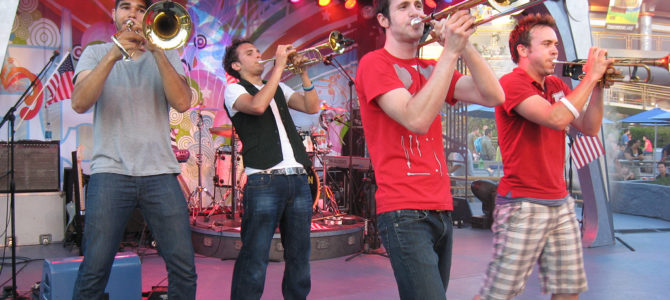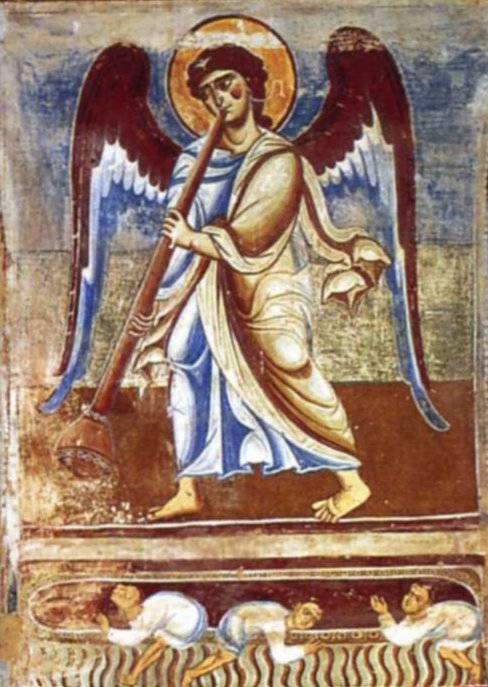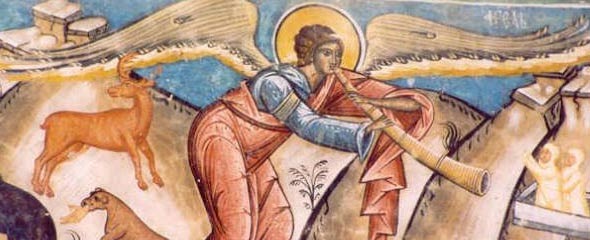
In the month leading up to Christmas, citizens across this great nation of ours dust off their “Messiah” scores to give George Fredric Handel’s venerable work another go. Both ordinary concerts and do-it-yourself-“Messiahs,” where audience members sing and play along, are quite popular.
In the “Messiah’s” memorable duet between solo bass and trumpet, Handel sets a passage from Paul’s first letter to the Corinthians, including: “Behold, I tell you a mystery; We shall not all sleep, but we shall all be changed, in a moment, in the twinkling of an eye, at the last trumpet: for the trumpet shall sound, and the dead shall be raised incorruptible, and we shall be changed.”
“The trumpet shall SOUND!” – duh-duh-DAH duh-da-duh-DAH!
Handel’s text-painting in this aria is pleasingly literal. The bass sings, “The trumpet shall sound,” and there the trumpet goes, sounding a fanfare reminiscent of the bugle calls used in military signaling, calls easy to play on the valveless, or natural, trumpets historically used in war, the context in which Paul mentioned trumpets earlier in his letter.
The observer may notice, though, that this “last trumpet” accompanying the singer is a bit odd: it may have four valves, not the three of your ordinary trumpet, and with a silvery, incisive tone—not the “fatter” brass of regular trumpets. If your musicality doesn’t extend to encyclopedic knowledge of the various mutations in the brass family, your reaction might be what mine first was: what is that thing?
Let’s Find Out
If your musical knowledge does, however, include familiarity with other major settings of sacred text for choir, you might also notice something else.
The Latin setting of the same passage reads, “Tuba, mirum spargens sonum”—the tuba, casting a wondrous sound. The German setting, exemplified by Johannes Brahms’s evocative “Ein deutsches Requiem,” takes its text from the Luther Bible and reads, “denn die Posaune wird erschallen”—then the trombone will sound. Brahms indeed scores his work so that the trombones sound right as they’re being mentioned.
Those keeping track might start to wonder if we should expect to waken to the sound of an entire brass choir on Judgment Day. Those more literal about Paul’s warning to not let our trumpets be uncertain might grow uneasy: just what is this “last trumpet” supposed to be?
The oddity of the four-valver often used these days as the “Messiah’s” last trumpet is easily explained: it’s just a piccolo trumpet. The fourth valve is there on most piccolo trumpets to improve range and intonation, but it’s not necessary: some models have three valves, just like an ordinary trumpet.
Piccolo trumpets weren’t around in Handel’s day, though. The lower notes of the trumpet’s theme in Handel’s aria aren’t just an artistic choice to evoke bugle calls in the mind of the listener, they also reflect what was musically possible back then, when trumpets were still natural, or valveless, like war horns. On a natural brass instrument, which relies on the overtone series to jump between pitches, scalar passages only become possible three octaves above the horn’s fundamental pitch.* Below that, the overtones are too sparse for stepwise motion.
Occasionally, a “Messiah” performance features a baroque trumpet, a modified reproduction of the natural instruments of Handel’s era, mellower-sounding than the piccolo trumpet. That is, mellower if you can play it well, no easy stunt. Good florid passages on natural horns are truly virtuosic. Handel often had precisely one virtuoso in mind when he wrote his trumpet parts.
The Tuba Shall Sound. But Look Like a Trumpet
Still, why should it be a trumpet at all, rather than the last trombone or tuba?
The Romans of Paul’s time used both curved and straight instruments in military signaling, and in what I’m told is characteristically practical Roman fashion, they named them after their shapes: The curved one, the one that looks most like a tuba or sousaphone to modern eyes, they called a cornu, or horn. The straight one, which looks like the long trumpets angels typically blow in Christmas decorations, they called a tuba, or tube. A charmingly dorky re-enactment comparing and contrasting these two Roman instruments has been filmed here.
The Latin isn’t wrong: the tuba shall sound. But the tuba shall look like a trumpet.
The modern tuba was only invented in 1835 and initially called the “bass tuba”—that is, a trumpet in the bass register. “Trumpet” is itself a diminutive of “trump”: not POTUS’s mini-me, but a word of Germanic origins describing a long tubelike brass instrument. In other words, a tuba.
That doesn’t yet explain the trombones, though. Still there they are, bold as brass, in the Luther Bible and consequently in the German imagination. “Germans are a little weird, and Luther was very German,” is one explanation. Another explanation: we haven’t yet exhausted our supply of Roman military horns to name stuff after.
The Roman buccina, superficially identical to the cornu, but slightly longer, with a narrower cylindrical rather than conical bore, survived the fall of the Roman Empire but “lost for ever the characteristic curve like a ‘C’ which it possessed in common with the cornu,” straightening out into a horn resembling the Roman tuba:
After a lapse of years during which records are almost wanting, the buccina reappeared all over Europe as the busine, buisine, pusin, busaun, pusun, posaun, busna (Slav), &c.; whether it was a Roman survival or a re-introduction through the Moors of Spain in the West and the Byzantine empire in the East, we have no records to show. An 11th-century mural painting representing the Last Judgment in the cathedral of S. Angelo in Formis (near Capua), shows the angels blowing the last trump on busines.
The mural in question reveals a scene all Christians are familiar with: angels blowing long, straight… trumpets. Nonetheless, posaun somehow resulted in the German word for trombone (Posaune), not trumpet—Germans call their trumpets trumpets (Trompeten). Picturing a modern trombone in an eschatological context is a bit incongruous. I imagine it off in the distance somewhere, barely audible, softly sliding its way through a lazy delta melody. That would be the world ending not with a blast of judgment, but a sort of jazzy whimper.

Or It Could Be a Trombone
Still, the modern trombone’s distant ancestor was a fairly ordinary-looking straight trumpet, albeit one with a built-in slide. The sackbut, the intermediary stage in the evolution from slide trumpet to trombone, puts in an appearance in the King James Bible, although perhaps a spurious one. Trombonists already have a reputation for being rather odd. Perhaps they’d be even odder if the name “sackbut” had stuck. It beats even “trombone” for innuendo.
Since slide trumpets were apparently the first kind of trumpet used in church, perhaps it’s not such a stretch to imagine angels playing trombones, after all. (A church-musician friend of mine remarked that maybe this is why the apocalypse hasn’t happened yet: the trombones keep missing their entrance.) An angel playing a modern tuba still remains hard for me to picture, although on Judgment Day I suppose we should be prepared for anything. Alphorns, perhaps?
An alphorn does rather resemble the lituus, yet another ancient Roman instrument used in battle, and one also named for its shape. Bach rather infamously wrote the only surviving music for the lituus, infamous because no one really knows what instrument, exactly, this lituus might have been.
Clever computer modelers have tried to reconstruct the lituus Bach might have had in mind, but considering the promiscuous naming-history even angelic brass instruments possess, perhaps we should leave it at “a brass instrument of some kind,” and not necessarily made of brass, either, since some litui were, like the alphorn, made of wood. This mural depicts an angel using a wooden alpine horn to wake the dead; a horn which, perhaps because it resembles an original lituus more than it does the other original Roman instruments, is naturally not named after the lituus, but after the buccina instead.

Trumpets, tubas, sousaphones, euphonia, bazookas (no, seriously), alphorns, litui, sackbuts, bugles, trombones, superbones, flugelhorns, vuvuzelas—all remain Apocalyptic contenders, as far as I’m concerned. The one horn I don’t expect to hear on Judgment Day is the tuba mirum, the invention of PDQ Bach, himself the invention of Peter Schickele.
The tuba mirum, superficially** a member of the hosaphone family named after the horn of last judgment is, in the words of its inventor, a “mere tube” half-filled with wine that functions somewhat like a slide whistle and sounds like “a flute slipping on a banana peel.” Although with God, all things are possible.
___________________________________________
* I checked the range of a natural D trumpet against my Messiah score, and yes, the trumpet’s entrance starts low enough to be in the range where it can only arpeggiate between harmonics. **Hosaphones are labrosones; the tuba mirum looks just like a hosaphone, but is played like a flute instead.









